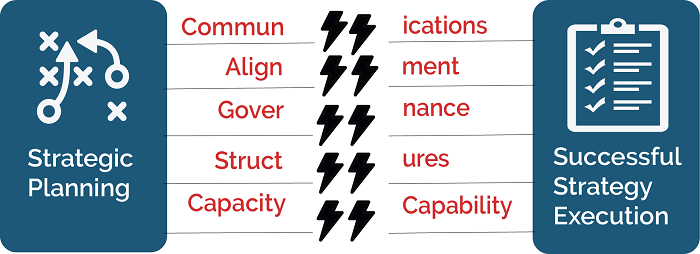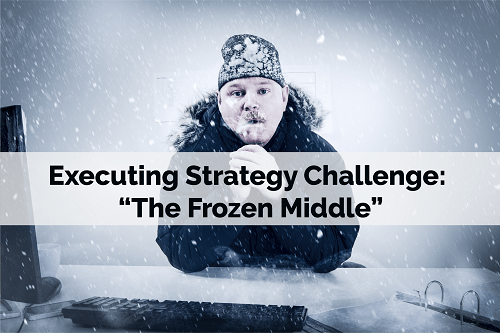 The “Frozen Middle” is a term used to stereotype middle managers in today’s workforce. It typically refers to those in mid-level management who allegedly block an organization’s progress because they aren’t capable, not motivated or afraid to take risks. This layer of management has a crucial role in ensuring the oversight of the processes involved in achieving the successful execution of strategic initiatives necessary for an organization to obtain its strategic goals.
The “Frozen Middle” is a term used to stereotype middle managers in today’s workforce. It typically refers to those in mid-level management who allegedly block an organization’s progress because they aren’t capable, not motivated or afraid to take risks. This layer of management has a crucial role in ensuring the oversight of the processes involved in achieving the successful execution of strategic initiatives necessary for an organization to obtain its strategic goals.
Simply stated, Strategy Execution is the process of implementing the organization’s strategy by leading and communicating effectively in a climate of teamwork, continuous improvement, innovation, and change. Organizational strategies, far too often, are developed in isolation without input from key stakeholders across the organization. This typically results in a strategy that no one really buys into, other than the small team of individuals who developed it. Whether good or bad, a strategy developed in this way can be difficult to nearly impossible to implement. Most of the strategy implementation work begins with middle management. While the ancient Egyptians may have decreed, “So shall it be written, so shall it be done;” in today’s business environment, that is much easier said than done.
Most everyone agrees the world is changing at an ever-increasing pace and the digitalized age is a game changer that has rendered most strategic organizational plans of the past impotent. Everything taken for granted in the organization and has worked in the past, must be re-examined and scrutinized to ensure organizational growth and sustainability in the upcoming decades.
In working with over 200 organizations worldwide, we have identified five major gaps between strategy development and its implementation. These gaps are ineffective communication, lack of alignment, ineffective governance, ineffective organizational structure, and mismatches in capacity and capability, shown in Illustration 1 below.

Illustration 1: Gaps Between Strategy Development & Implementation
These five gaps are often manifested at the mid-level of the organization as this is where implementation of strategy succeeds or fails. Failure to recognize and properly address these gaps at the executive level of an organization can result in the Frozen Middle phenomena, raising many issues and concerns.
The following compilation is based on conversations with and observations of middle managers over the last 30 years. While this summary is not based on any scientific fact or studies, I believe it to provide some insight into some of the reflections offered by mid-level managers. While not all apply equally to every organization, I believe they contain some valuable content leaders might want to consider and think about.

Fear – many middle managers are afraid of failing. They fear the backlash and consequences of not meeting the expectations of senior management. The added stress of this fear is real and can result in poor job performance as well as illness.
Risk – risk at this level comes at you from every direction: above, below and sideways. Sometimes this is real; sometimes imaginary. Whatever the case, is your organization one that encourages and rewards risk taking that is well thought out and planned, or is it a punitive one that failure is not ever acceptable?
Over-tasked –Middle managers today tend to be pulled in multiple directions, wear multiple hats and work long hours. Poor work-life balance adds stress which can negatively impact performance.
Zone of Resistance – often middle managers are forced to deal with trying to accomplish executive mandates without the necessary resources. Often there are competing projects resulting in middle managers becoming frustrated as their efforts to obtain additional resources to accomplish everything fall on deaf ears. This sometimes results in the tendency to become defensive and negative when new projects come their way.
Exclusion – middle managers tend to not really belong to any social group in their organization. They must maintain a proper manager-subordinate role whether dealing with those below them or those above them. Many do not choose to confide in their peers at this level due to a lack of trust due to perhaps seeing their peers as competition. As a result, social isolation at this level of the organization is something real in many organizations.
 Not Appreciated –middle managers often go uncompensated or rewarded for outstanding work. Often the praise, bonuses, and recognition for getting the job done goes to the leaders at the executive level. This can lead to dissatisfied managers, which can translate into unsatisfied workers reporting to them. Similarly, middle managers often feel they don’t have a great chance of promotion and aren’t provided with the opportunity to provide input to decisions that affect them.
Not Appreciated –middle managers often go uncompensated or rewarded for outstanding work. Often the praise, bonuses, and recognition for getting the job done goes to the leaders at the executive level. This can lead to dissatisfied managers, which can translate into unsatisfied workers reporting to them. Similarly, middle managers often feel they don’t have a great chance of promotion and aren’t provided with the opportunity to provide input to decisions that affect them.
Mediocracy – when the middle layer of management feels underappreciated, overworked and overly criticized, there exists a tendency to become complacent. A “don’t rock the boat” mentality ensues that is not healthy for the growth of an organization.
Incompetent – poor leadership often drives feelings of inadequacy, failure, and anger in middle management. This typically has a negative impact on the manager, and he/she begins to doubt their self-worth and reduce any behavior that might invite scrutiny.
Disregarded – senior executives do not even know who I am or that I exist. “No recognition ever comes to me personally or my employees, regardless of how hard we might have worked.” They never hear the words, “Thanks – you folks did a fantastic job!”
Disrespected – sometimes, when asked for an opinion, they offer it only to be rebuked and criticized for their thoughts. This discourages engagement and can increase feelings of animosity towards leadership and the organization. Everyone wants to feel their ideas are valued and considered, even if not implemented.
Lethargy – middle managers who struggle with many of these elements eventually arrive at a state of physical and mental weariness. Work fatigue can negatively impact their ability to create value for the organization – they are too tired to work and too tired to care.
Expendable – middle managers sometimes feel like the “fall guy/gal.” If something goes south, they feel like their career is on the chopping block. This leads to distrust and poor attitudes, which tend to spread from middle management down. If middle management doesn’t trust upper management, no one will.
Successful strategy execution comes down to leadership, not just at the top of the organization, but at all levels. Does your organization have what it takes to successfully execute strategy at the middle management level or are you headed for the ice age?
Terry is Balanced Scorecard Institute's Director of Training and Senior Associate with over 30 years of experience working in both the private and public sectors.


